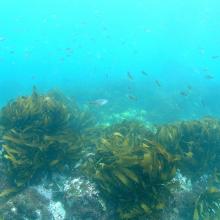

Shizugawa-wan
- Country:Japan
- Site number:2358
- Area:5,793 ha
- Designation date:18-10-2018
- Coordinates:38°40'N 141°31'E
Materials presented on this website, particularly maps and territorial information, are as-is and as-available based on available data and do not imply the expression of any opinion whatsoever on the part of the Secretariat of the Ramsar Convention concerning the legal status of any country, territory, city or area, or of its authorities, or concerning the delimitation of its frontiers or boundaries.
Overview
Located on the southern Sanriku Coast on the Pacific Ocean, Shizugawa-wan is a bay (wan) encompassing a number of scattered islands such as Areshima and Tsubakishima. Its complex “ria coast”, featuring capes and inlets formed by submerged river valleys, includes various subtidal habitats such as reef zones, silt grounds and mudflats; these support extremely diverse vegetation, including 208 species of seaweeds and seagrasses. The Site is influenced by three ocean currents, the cold “Oyashio” and the warm “Kuroshio” and “Tsugaru” currents, enabling warm- and cold-water kelp to coexist. This uncommon environment provides habitats or feeding grounds for 553 animal species. The abundant seaweeds and seagrasses make the Site an ideal wintering ground for brent geese (Branta bernicla nigricans), white-tailed eagles (Haliaeetus albicilla) and Steller’s sea eagles (Haliaeetus pelagicus), all of which are designated as natural monuments of Japan under the National Red List and the Law for the Conservation of Endangered Species of Wild Fauna and Flora (LCES). The Site is the southernmost wintering ground for brent geese in Japan. The bay supports local livelihoods including the farming of seaweed (wakame), oysters and fish such as coho salmon (Oncorhynchus kisutch). The 2011 tsunami had a great impact on the seaweed beds, but the bay has been recovering steadily.
Administrative region:
Minamisanriku Town / Miyagi Prefecture / Honsyu, Tohoku District
- National legal designation:
- National Park, Marine Park Zone - Sanriku reconstruction National Park, Marine Park Zone
- Last publication date:17-10-2018
Downloads
Ramsar Information Sheet (RIS)
Site map
Additional reports and documents
- Taxonomic lists of plant and animal species occurring in the site
- Other published literature
